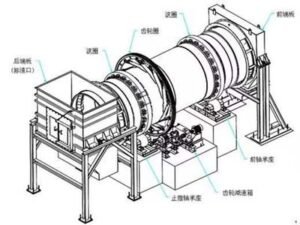
The working principle of rotary kiln mainly involves material movement, gas flow, fuel combustion and heat transfer and other interrelated processes:
1. Material movement
The raw material enters the barrel from the kiln end. Due to the inclined installation and slow rotation of the kiln body, the material will produce a compound movement that rolls in the circular direction and moves from the high to the low end along the axis, just like a circular spring, which keeps advancing and successively passes through the drying, preheating, decomposition, burning and other areas, and finally discharged from the kiln head after calcining the mature material.
2. Gas flow
After the fuel is injected into the kiln head for combustion, the generated hot flue gas flows in reverse with the material. After the hot flue gas transfers heat to the material, it is discharged from the kiln tail and discharged into the atmosphere by the chimney after collecting dust.
3. Fuel combustion
The fuel is injected into the high temperature zone of the kiln from the kiln head, and fully burns under the action of natural or mechanical ventilation, releasing a lot of heat to provide the required heat energy for the calcination of the material.
4. Heat transfer
The heat generated by fuel combustion is transferred to the material by means of thermal radiation, thermal convection and thermal conduction, so that the temperature of the material increases and a series of physical and chemical changes occur. During the heat transfer process, the thermal system in the kiln needs to be kept stable to ensure that the material can be evenly heated and fully calcined.

